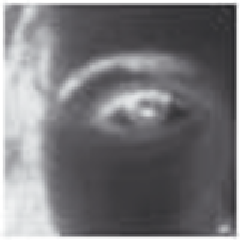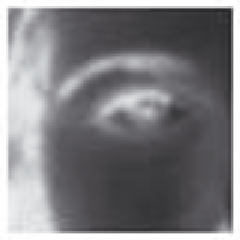Image Processing Reference
In-Depth Information
3.4.4
Gaussian averaging operator
The
Gaussian averaging operator
has been considered to be optimal for image smoothing.
The template for the Gaussian operator has values set by the Gaussian relationship. The
Gaussian
function
g
at co-ordinates
x
,
y
is controlled by the variance σ
2
according to:
22
2
xy
+
-
2
σσ
gxy
(,
) =
e
(3.22)
Equation 3.22 gives a way to calculate coefficients for a Gaussian template which is
then convolved with an image. The effects of selection of Gaussian templates of differing
size are shown in Figure
3.16
. The Gaussian function essentially removes the influence of
points greater than 3
3
operator, Figure
3.16
(a), retains many more of the features than those retained by direct
averaging (Figure
3.14
). The effect of larger size is to remove more detail (and noise) at the
expense of losing features. This is reflected in the loss of internal eye component by the 5
in (radial) distance from the centre of the template
The 3
5 and 7
7 operators in Figures
3.16
(b) and (c), respectively.
(a) 7
7
(a) 3
3
(a) 5
×
5
Figure 3.16
Applying Gaussian averaging
A surface plot of the 2D Gaussian function of Equation 3.22 has the famous bell shape,
as shown in Figure
3.17
. The values of the function at discrete points are the values of a
Gaussian template. Convolving this template with an image gives Gaussian averaging: the
point in the averaged picture is calculated from the sum of a region where the central parts
of the picture are weighted to contribute more than the peripheral points. The size of the
template essentially dictates appropriate choice of the variance. The variance is chosen to
ensure that template coefficients drop to near zero at the template's edge. A common
choice for the template size is 5 ×
5 with variance unity, giving the template shown in
Figure
3.18
.
This template is then convolved with the image to give the Gaussian blurring function.
It is actually possible to give the Gaussian blurring function antisymmetric properties by
scaling the
x
and
y
co-ordinates. This can find application when an object's shape, and
orientation, is known prior to image analysis.



















